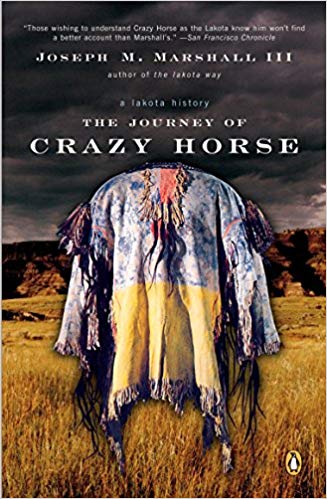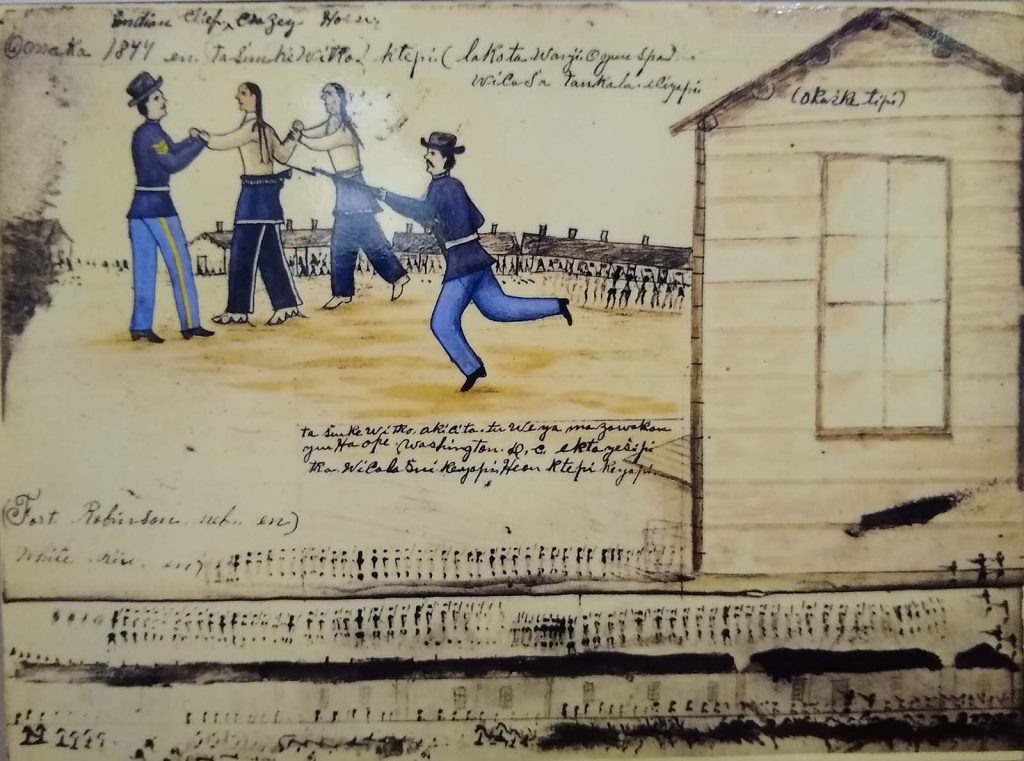When you hear the name Crazy Horse, many people conjure up images of the Oglala Lakota war leader fighting at such places as the Battle of the Rosebud, Battle of the Hundred-in-the-Hands (Fetterman Fight), and the Battle of the Greasy Grass (Battle of the Little Bighorn) to retain the Lakota way of life.
From the beginning of his life until his death at Camp Robinson, Crazy Horse stood apart from the rest of his people. He never courted fame. He didn’t participate in the usual ritual of bragging about his accomplishments. He preferred to spend time in solitude, but knew how to lead when the time came.
Lakota author Joseph M. Marshall III’s “The Journey of Crazy Horse” is an intimate portrait of the Lakota leader in vivid detail without hero worship. Marshall shows us a man who was set apart from his people during a vision quest, yet is one who always looks out for others while leading his people in their struggle to remain free.
Throughout the book, Marshall avoids the usual descriptions of bloodshed and violence of battles, choosing to remain focused on the man who was called to lead his people. By doing so, the reader gets a clear picture of the reasons why Crazy Horse and others like him remained defiant.
Much has been written about Crazy Horse and his exploits as a Lakota warrior. While some of that is in this book, Marshall eloquently brings us the great leader fighting to keep his people’s land while honoring the humility he felt compelled to display after his vision quest.
The book is based on oral history and Marshall presents it in an easy-to-read style that keeps the reader engaged in Crazy Horse’s life while finding a new respect for the Lakota way of life.
“The Journey of Crazy Horse” is one of the more enjoyable books I have ever read. Throughout the book, not only did I identify with Crazy Horse due to similarities in our personalities, but I saw a man that is an inspiration to others regardless of whether or not they are Lakota.
The book separates the many myths of Crazy Horse that have cropped up over the years. Marshall also delves into the complex set of events in Crazy Horse’s life that influenced him to protect the traditions and culture of his people.
It is difficult to read the description of Gen. William Harney’s attack on Brulé Lakota chief Little Thunder‘s camp in what is now northwest Nebraska and not see how the trauma Crazy Horse witnessed would change his views on the whites. After this, Crazy Horse was determined to never give in to them and to always be “suspicious and distrustful of such intruders forever.”
At the time of the attack, Crazy Horse was returning from a hunting trip when he came across Little Thunder’s burned-out village. He witnessed dead and mutilated bodies.
“Most of us can only imagine the searing, gut-wrenching impact the sight of a horribly mutilated body would have on us. Such an experience would – and does – assault all of the physical senses. It burns indelible imprints into the memory that may fade a little through the passage of time, but will never go away.
“That raw and ugly episode set the stage for his later interaction with whites. It was likely the single most compelling reason he could not bring himself to think of whites as caring or nurturing people, or as anyone to be trusted.” Pg. 109
Finding such horror forever changed Crazy Horse’s feelings toward white people. It is through this retelling that Marshall aptly describes how such a trauma changes the way a person thinks. Through Marshall’s words, the reader gains an insight and sympathy toward a man who just wanted to be left alone to live his life as his ancestors always had.
Marshall describes Crazy Horse as a person of quiet nature, shyness, and contemplation. He was “calm and deliberate and given to long moments of introspection.” According to Marshall, Crazy Horse was quiet, soft-spoken, and often serious. He was also made fun of because he was different.
“They remembered that he was so small when he had lost his mother, and that he had steadfastly endured the teasing of other boys because his hair was very light colored and wavy. Not unlike so many, he had already faced much difficulty in his life.” Pg 101
The picture of Crazy Horse that Marshall paints is what continually drew me in to learn more about this man who seemingly had a temperament I find compelling and worthy of respect.
Crazy Horse also found the need to get away from everyone and everything. It was in his nature, but he also sought solitude when he needed to make important decisions.
“But he was not good at thinking and weighing all the factors of a situation when others were around … solitude had always been one of his best allies. So he sought out the solitude of the prairies or the mountain slopes. He needed the reassuring silence broken only by the passing breeze or the distant howl of a wolf. In such places, he could gather his thoughts and pile them up like stones and then examine them, one by one.” Pg. 175
Naturally, Crazy Horse’s family and friends did not think he should wander off so often. They worried about his safety, but they also felt as a leader, his place was to remain with his people. Crazy Horse did what he wanted to do and went off by himself when he felt the need. He never asked permission from anyone and found respite when he needed it.
Marshall’s excellent story-telling shines in Part IV of the book as he weaves the two separate stories of Crazy Horse and his people arriving at Camp Robinson with his travel to meet those already at Camp Robinson, which led to his death.
Marshall also addresses the many ways Crazy Horse has been portrayed over time. He speaks about how Crazy Horse has been “many things to many people.” We each see something in Crazy Horse that we admire and learn from, “For it was as a real person he left tracks both on the Earth and in the hearts of men and women who truly know him.”
“Crazy Horse was not perfect or so overwhelmed with righteousness that he was incapable of dark thoughts or doubts. Nor was he impervious to all the foibles of being human. He was very human. He learned his lessons, he laughed, he loved, he was driven by loyalty, anger, patriotism, and he did his best not certain it would be good enough. He knew cold and hunger and fear and self-doubt…..In short, he was a man like many others, and in many ways he was a man like no other.” Pg 285-286
“Perhaps his bones have turned to stone, as he said they would. But his spirit has risen because he does live in the minds of many Lakota, and also because he has found his place in our hearts. And that, I believe, is the best place for him to be because the human heart is stronger than stone.” Pg. 289
Crazy Horse was a great leader, but it is the man of solitude and quiet contemplation I identify with, and I am forever grateful to Marshall for bringing that part of Crazy Horse’s character and life to light.



1 Pingback